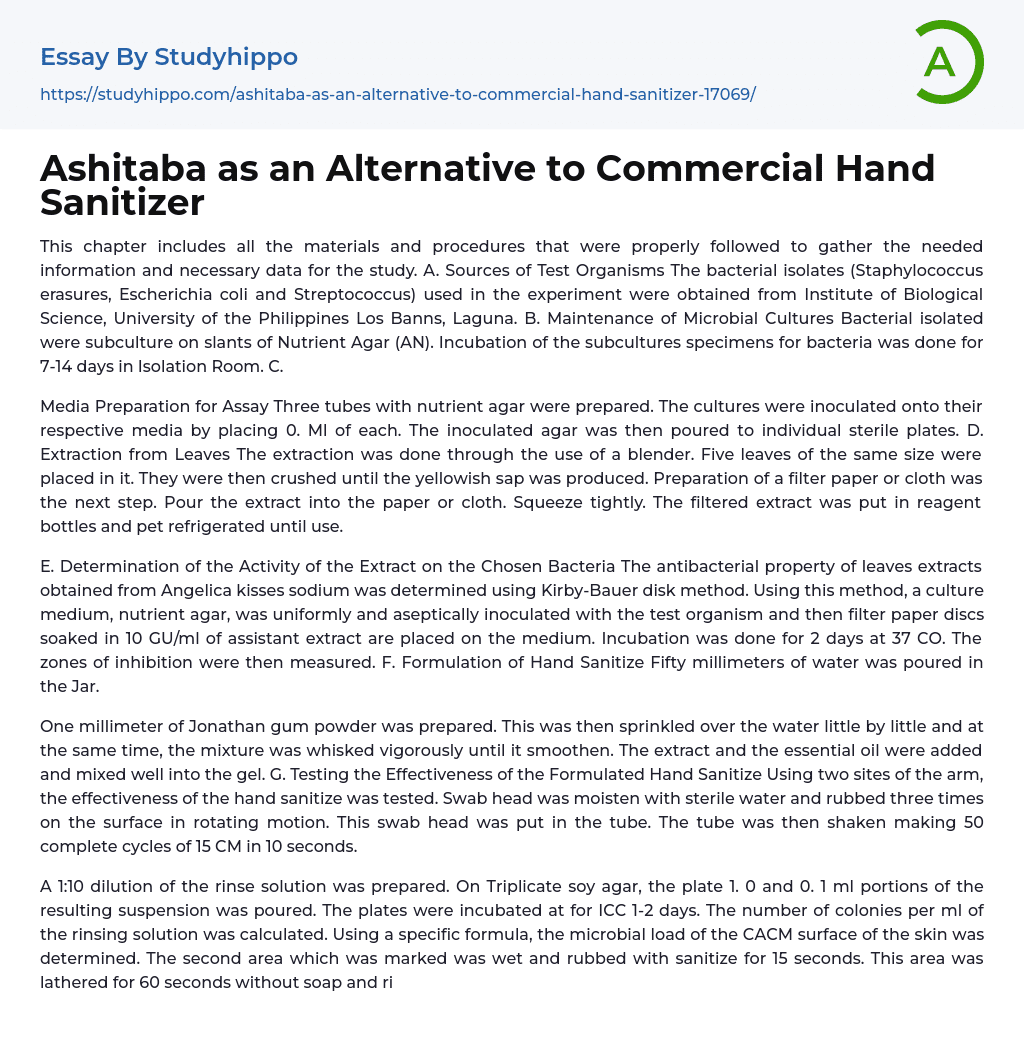

Ashitaba as an Alternative to Commercial Hand Sanitizer Essay Example
This chapter examines the materials and procedures utilized to collect essential information and data for the study. The bacterial isolates (Staphylococcus erasures, Escherichia coli, and Streptococcus) used in the experiment were obtained from the Institute of Biological Science, University of the Philippines Los Banos, Laguna. The bacterial isolates were subcultured on slants of Nutrient Agar (AN) and incubated for 7-14 days in an Isolation Room. To prepare the media for the assay, three tubes containing nutrient agar were prepared. Each tube was inoculated with 0.1 mL of the respective cultures. The inoculated agar was then poured into individual sterile plates.
Extraction from leaves involved using a blender to crush five leaves of equal size until yellowish sap was produced. A filter paper or cloth was prepared, and the extract was poured into it and squeezed tightly. The fil
...tered extract was stored in reagent bottles and refrigerated until use.
The antibacterial activity of leaf extracts from Angelica kisses sodium was determined through the Kirby-Bauer disk method. This method entailed inoculating a culture medium (nutrient agar) with a uniform and sterile test organism. Filter paper discs soaked in an assistant extract concentration of 10 GU/ml were placed on the medium, which was then incubated at 37°C for 2 days. Finally, any resulting zones of inhibition were measured.
To create the hand sanitizer, a jar was filled with 50 milliliters of water. Next, 1 millimeter of Jonathan gum powder was gradually sprinkled into the water while vigorously whisking the mixture until it became smooth. The extract and essential oil were then added and thoroughly mixed into the gel.
In order to test the effectiveness of the formulated hand sanitizer, two areas o
the arm were selected. A swab head moistened with sterile water was rubbed three times in a rotating motion on each surface. The swab heads were then placed into tubes and shaken for a total of 50 cycles lasting 10 seconds each. A rinse solution diluted at a ratio of 1:10 was prepared and poured onto soy agar plates in portions of both 1.0 ml and 0.1 ml (triplicate). After incubating for 1-2 days at ICC temperature, the number of colonies per ml in the rinse solution was calculated using a specific formula to determine the microbial load on the skin surface.
The second marked area on the skin was wetted and rubbed with the hand sanitizer for 15 seconds. Meanwhile, for comparison, soapless lathering for 60 seconds followed by rinsing with sterile water for another 15 seconds took place on the first area. Some steps were repeated to establish COIF/CM values for this second washed region.
Additionally, bacterial cultures were treated with extracts from Assistant leaves to assess their antibacterial activity after seven days. The plates were examined based on zone diameter inhibition measurements. Finally, hand sanitizer containing these extracts was created and tested specifically on a designated part of the skin.
I compared the amount and composition of microorganisms on treated and untreated skin surfaces as part of my science investigatory project. I will upload the remaining chapters once I have completed my study.
- Organic Chemistry essays
- Acid essays
- Calcium essays
- Chemical Bond essays
- Chemical Reaction essays
- Chromatography essays
- Ethanol essays
- Hydrogen essays
- Periodic Table essays
- Titration essays
- Chemical reactions essays
- Osmosis essays
- Carbohydrate essays
- Carbon essays
- Ph essays
- Diffusion essays
- Copper essays
- Salt essays
- Concentration essays
- Sodium essays
- Distillation essays
- Amylase essays
- Magnesium essays
- Acid Rain essays
- Agriculture essays
- Albert einstein essays
- Animals essays
- Archaeology essays
- Bear essays
- Biology essays
- Birds essays
- Butterfly essays
- Cat essays
- Charles Darwin essays
- Chemistry essays
- Dinosaur essays
- Discovery essays
- Dolphin essays
- Elephant essays
- Eli Whitney essays
- Environmental Science essays
- Evolution essays
- Fish essays
- Genetics essays
- Horse essays
- Human Evolution essays
- Isaac Newton essays
- Journal essays
- Linguistics essays
- Lion essays



